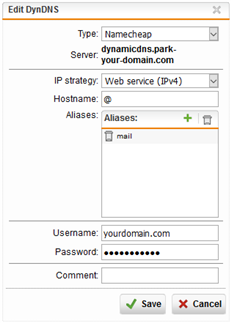Has anyone tried to use the Namecheap type under DynDns? I'm trying to use it, but there is something a bit perplexing about it. According to Namecheap's official support page, you do not need a username in order to update the IP address for your domain name. All you need is the hostname, domain name, the domain password, and the IP address.
https://www.namecheap.com/support/knowledgebase/article.aspx/29/11/how-to-use-the-browser-to-dynamically-update-hosts-ip
https://www.namecheap.com/support/knowledgebase/article.aspx/596/11/using-dynamic-dns-client-version-001
So what perplexes me is that in Sophos UTM 9, when I select the namecheap option from Network Services > DNS > DynDns, it asks me to enter a username. Does anyone know what username I'm supposed to put there?
I've tried using my namecheap username and have tried both my normal namecheap password as well as my domain password for the dynamic dns feature and all I get is a message in the "DynDNS status is:" section saying "The last update attempt failed."
In my opinion, Sophos should NOT be asking for a username for namecheap DNS - please correct me if I'm wrong. If I'm correct, this is a bug and should be fixed.
Thanks,
Jonathan
This thread was automatically locked due to age.



